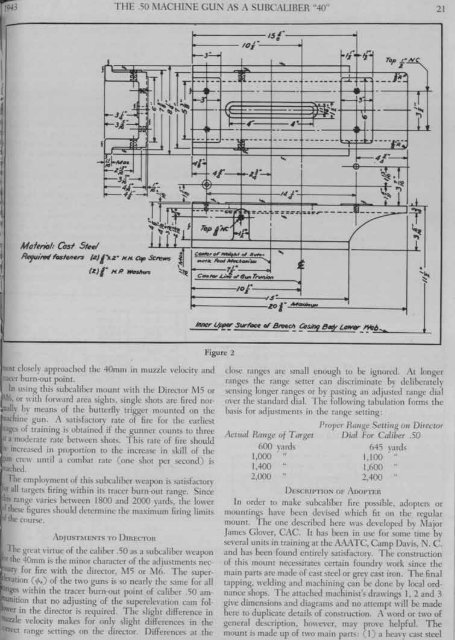July-August - Air Defense Artillery School
July-August - Air Defense Artillery School
July-August - Air Defense Artillery School
Create successful ePaper yourself
Turn your PDF publications into a flip-book with our unique Google optimized e-Paper software.
{<br />
,.<br />
j<br />
I<br />
/9-13 THE .50 I\IACHI0JE GU0J AS A SlIBCALIBER "40" 21<br />
mu~tclosely approached the 40mm in muzzle velocity and<br />
racer burn-out point.<br />
In using this subcaliber mount with the Director 1\'15 or<br />
\16. or with forward area sights, single shots are fired nor-<br />
~ally by means of the butterAy trigger mounted on the<br />
achine gun. A satisfactory rate of fire for the earliest<br />
ta~es of training is obtained if the gunner counts to three<br />
a moderate rate between shots. This rate of fire should<br />
increased in proportion to the increase in skill of the<br />
n crew until a combat rate (one shot per second) is<br />
ached.<br />
The employment of this subcaliber weapon is satisfactory<br />
r all targets firing within its tracer burn-out range. Since<br />
his range varies between 1800 and 2000 yards, the lower<br />
these figures should determine the maximum firing limits<br />
the Course.<br />
AD)UsT:\rENTs TO DmECTOH<br />
'I he great virtue of the caliber .50 as a subcaliber weapon<br />
r the 40mm is the minor character of the adjustments necry<br />
for nre with the director, 1\15 or 1\16. The supervation<br />
(9.) of the two guns is so nearly the same for all<br />
ges within the tracer burn-out point of caliber .50 amunition<br />
that no adjusting of the superele\'ation cam fol-<br />
'er in the director is required. The slight difference in<br />
Uzzle velocity makes for only slight differences in the<br />
nect range settings on the director. Differences at the<br />
Figure 2<br />
I<br />
- - -- - ~=..~-<br />
...<br />
....<br />
J<br />
I<br />
....L. • ...J<br />
Top .!.:NC<br />
,z<br />
___ .JI~_ ..~"<br />
J......<br />
1<br />
close ranges arc small enough to be ignored. At longer<br />
ranges the range seller can discriminate by deliberately<br />
sensing longer ranges or by pasting an adjusted range dial<br />
O\'er the standard dial. The following tabulation forms the<br />
basis for adjustments in the range selling:<br />
Act /fal Hange of Target<br />
600 vards<br />
1,000 "<br />
1,400<br />
2.000<br />
Proper Hallge Settillg 011 Director<br />
Dial For Caliber .50<br />
DESCIUPTION OF ADOPTER<br />
645 vards<br />
1,100<br />
1,600<br />
2,400<br />
In order to make subcaliber fire possible. adopters or<br />
mountings have been devised which fit on the regular<br />
mount. The one described here was developed by 1\ la jor<br />
James Glover, CAe. It has been in use for some time by<br />
several units in training at the AAATC, Camp Davis, N. C.<br />
and has been found entirelv satisfactorv. The construction<br />
of this mount necessitates ~ertain fou~dry work since the<br />
main parts are made of cast steel or grey cast iron. The final<br />
tapping, welding and machining can be done by local ordnance<br />
shops. The attached machinist's drawings 1, 2 and 3<br />
give dimensions and diagrams and no attempt will be made<br />
here to duplicate details of construction. A word or two of<br />
general description. however. may prove helpful. The<br />
mount is made up of two main pans: (I) a hea\'y cast steel
















